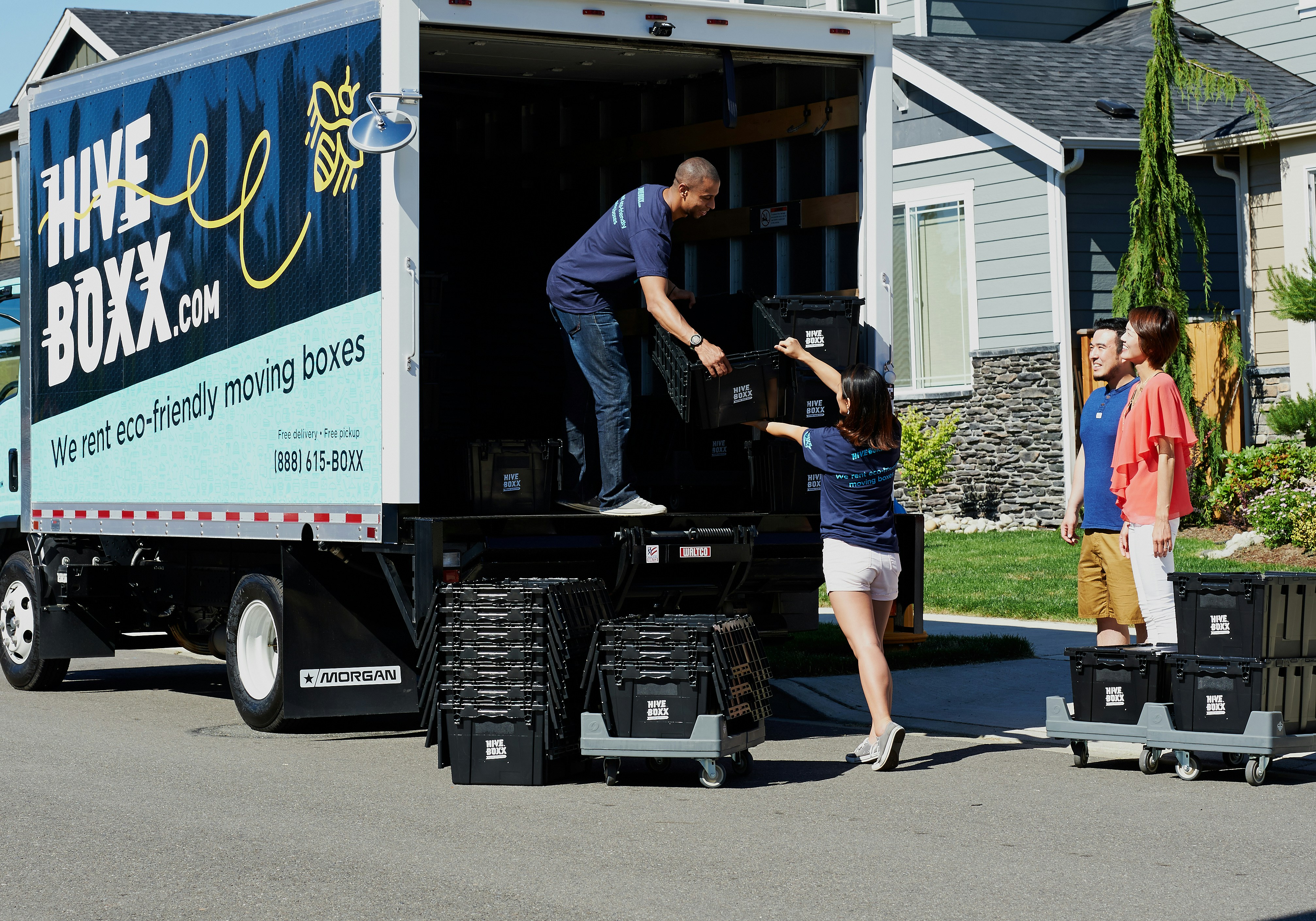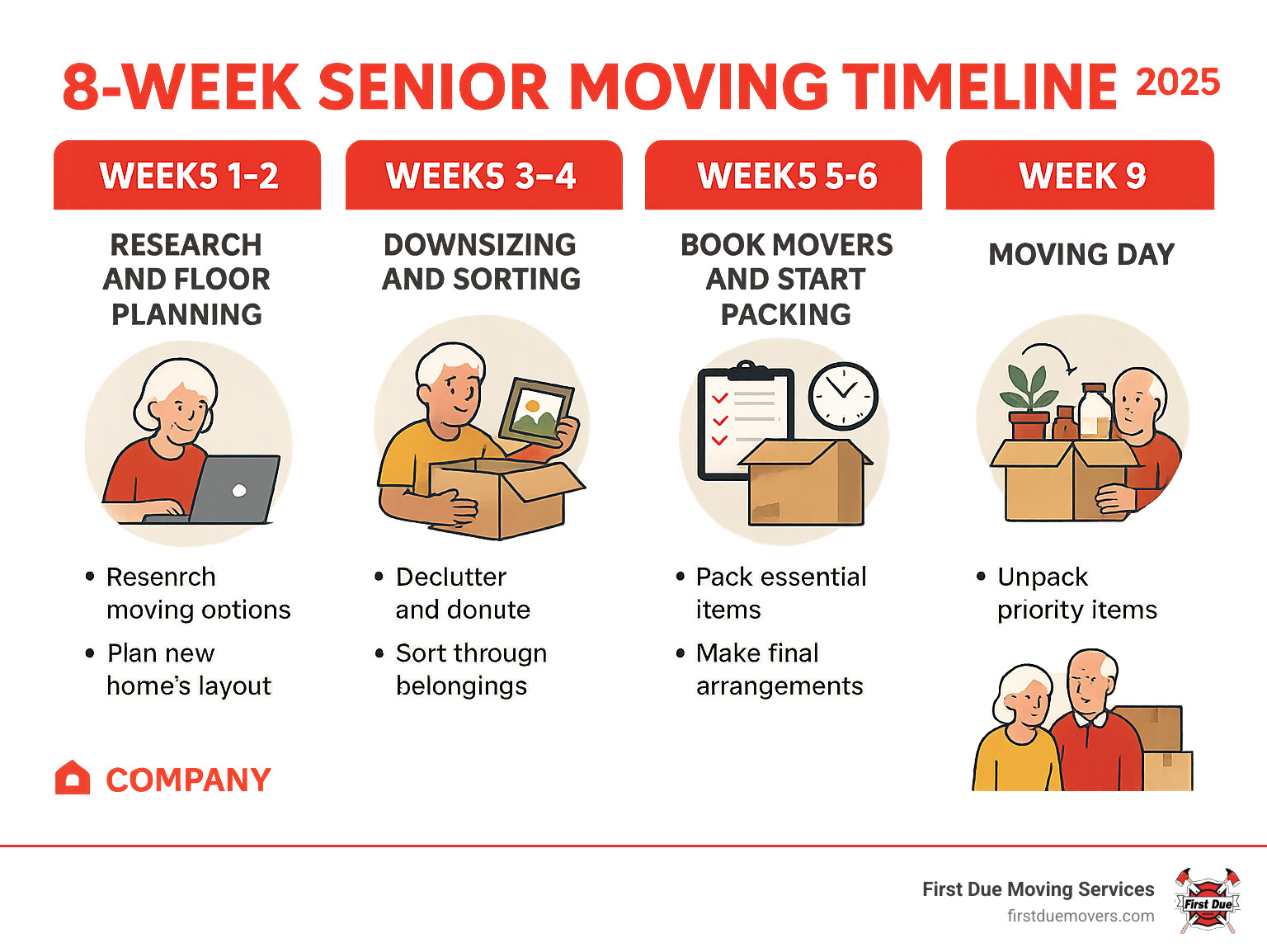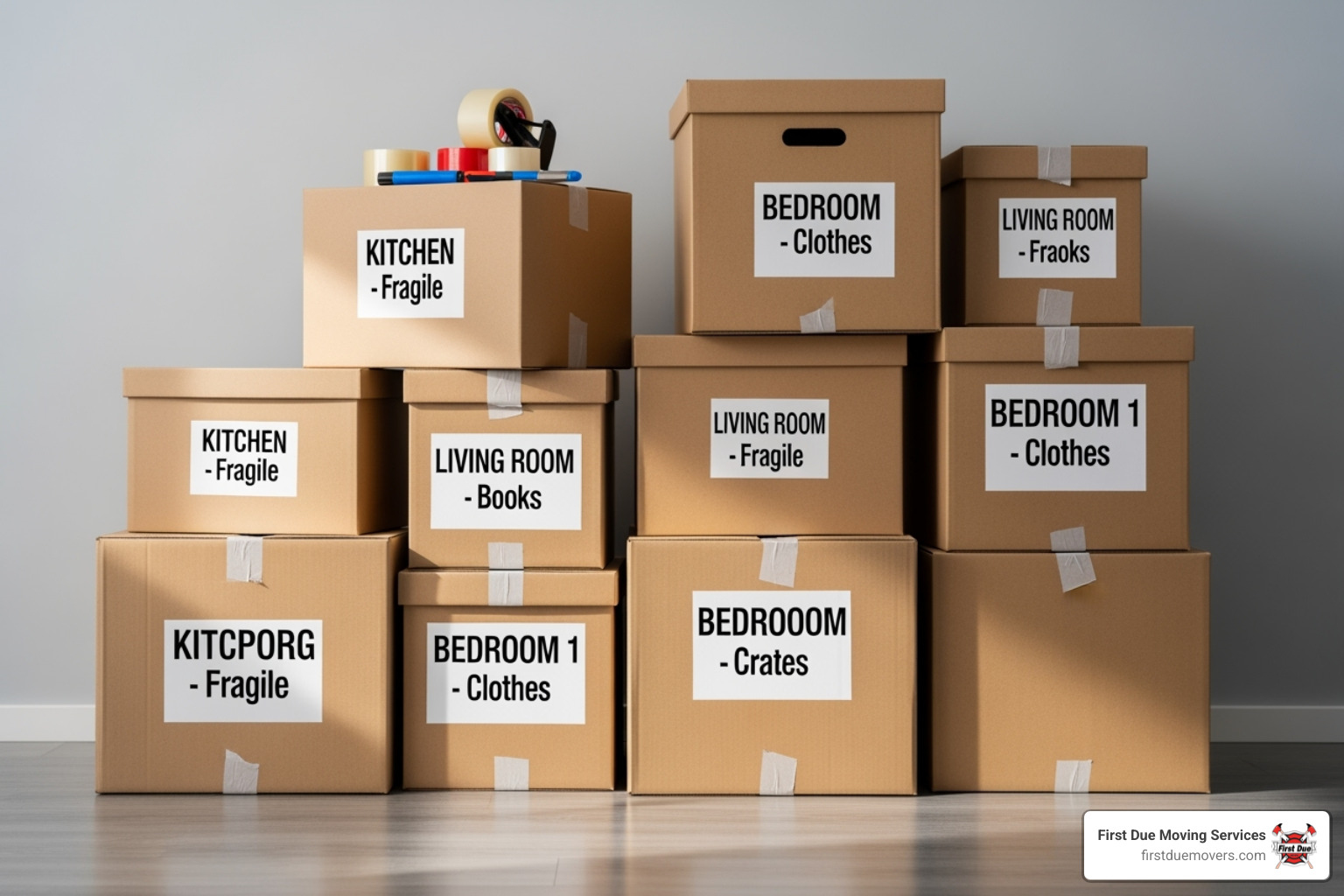Helping Elders Move: Essential Tips for a Smooth Transition
.webp)

Senior moving packing: Ultimate Smooth 2025
Why Senior Moving Packing Requires Special Care and Planning
Senior moving packing involves unique challenges that go far beyond simply putting items in boxes. More than 3 million older adults move every every year, with those 85 and older among the most mobile. Almost 340,000 American seniors retired to a new home in 2023, according to AARP.
Quick Guide to Senior Moving Packing Success:
- Start early: Begin planning 2-3 months in advance
- Downsize first: Use the “one-year rule” – if not used in a year, consider letting it go
- Pack strategically: Heavy items in small boxes, label everything clearly
- Create an “Open First” box: Include medications, documents, and immediate necessities
- Get help: Family support or professional movers reduce stress and physical strain
- Stay safe: Use proper lifting techniques and take frequent breaks
Moving later in life brings both physical and emotional challenges that younger movers rarely face. Seniors often struggle with bending down to pack boxes, lifting heavy items, and the overwhelming task of sorting through decades of memories and possessions.
The emotional toll can be just as significant. Leaving a long-time family home means saying goodbye to countless memories. About 51% of retirees move into smaller homes after retirement, which adds the complexity of downsizing cherished belongings.
But here’s the good news: with proper planning, the right support system, and smart packing strategies, senior moves can be smooth and stress-free. Whether you’re helping an aging parent or planning your own transition to a new chapter, this guide will walk you through every step of the process.
The key is understanding that senior moving packing isn’t just about logistics – it’s about honoring a lifetime of memories while embracing new possibilities.

The First Step: Planning and Downsizing for a New Chapter

The thought of packing up a lifetime of memories can feel overwhelming. But here’s what we’ve learned from helping countless families: the magic happens in the planning. When you break down senior moving packing into manageable steps, what once seemed impossible becomes achievable.
Think of this phase as laying the foundation for your new adventure. Just like our firefighter founders plan every detail before entering a challenging situation, successful senior moves require the same thoughtful preparation and emotional support.
Creating a Manageable Moving Timeline
Start planning 2-3 months ahead. Rushing creates unnecessary stress, and those extra weeks are your secret weapon for a smooth transition.
Break the process into weekly goals, like exploring your new neighborhood or sorting a guest room. This approach prevents overwhelm when facing an entire house of belongings.
Handle practical details early. Schedule donation pickups, as charities often book weeks in advance. You’ll also want to notify important parties about your move, including updating your address with the postal service and the Social Security Administration.
Banks, healthcare providers, and insurance companies all need time to process address changes. For a comprehensive approach to staying organized, check out our guide on how to organize your long distance move.
Effective Downsizing Before Senior Moving Packing
Downsizing is tough. It’s about memories and history, but it can also be freeing.
Start with your new space’s floor plan in hand. Measure everything to ensure furniture will fit, avoiding moving day surprises.
The “one-year rule” is a great guideline: if you haven’t used an item in a year, consider letting it go. Sentimental items are an exception.
Tackle this room by room to avoid overwhelm. Use four categories: Keep, Donate, Sell, and Gift. Gifting items to family can be a beautiful way to pass on memories.
For sentimental items that won’t fit, taking pictures of the current home and items can preserve the memory without taking up space.
This process works best with emotional support. Having someone listen to your stories and help you make decisions makes all the difference. For more strategies, explore our tips to declutter belongings.
Special Considerations for Moving to a Smaller Space or Assisted Living
Moving to a smaller living space or assisted living community requires a new mindset. Focus on creating a space that supports your daily routines and brings you joy.
Comfort items are a priority. A favorite chair, family photos, or a special coffee mug are essentials for feeling at home.
Multi-functional furniture is your best friend in smaller spaces. An ottoman with storage or a bed with built-in drawers can maximize your space.
Before packing, check your new community’s rules and guidelines. Some facilities have restrictions on appliances or furniture sizes, and it’s best to know these upfront.
Medical equipment and mobility aids require special attention for safe transport, as they are essential for health and independence. Our team has experience moving medical equipment out of state, ensuring it arrives safely. This is about creating a new space that fits the life you want to live.
Mastering Senior Moving Packing: Strategies for a Stress-Free Experience

Now that you’ve tackled the planning and downsizing phases, it’s time to master the actual senior moving packing process. With the right approach, what seems overwhelming becomes surprisingly manageable.
The secret to successful senior packing lies in preparation, organization, and taking it one step at a time. This isn’t a race – it’s about ensuring your treasured belongings arrive safely at your new home while keeping stress levels low.
Gathering the Right Packing Supplies
Having the right supplies is key. Sturdy boxes in various sizes are the foundation; we recommend new, quality boxes over used ones that might fail.
Avoid overloading boxes to ensure they can be lifted safely. Packing tape, bubble wrap, and markers are essential, while specialty boxes for clothes or dishes are game-changers. Wardrobe boxes prevent wrinkles, and dish packs protect china. The extra cost is worth the protection. For detailed guidance, check our guide on getting the right packing supplies for specific needs. These tips on how to pack a moving box like the pros are also helpful.
Smart Packing and Labeling Techniques
The most successful senior moving packing follows a systematic approach: pack room by room. This method keeps you organized and makes unpacking easier. Start with the least-used rooms first, like a guest room or garage, to build momentum without disrupting daily routines.
Color-coded labels transform chaos into clarity. Your labeling details should include the contents, destination room, and any special handling instructions like “FRAGILE”.
Here’s a pro tip: keep box weight manageable. Pack heavy items in small boxes—think books or tools. Lighter items like pillows and blankets can fill larger boxes without creating lifting hazards. This strategy is crucial for seniors and family members helping with the move. For a complete breakdown of this approach, our room by room packing strategy provides detailed guidance.
The “Open First” Box: Your Moving Day Lifesaver
Every successful senior move has a secret weapon: the “Open First” box. It’s your lifeline during those first crucial hours in your new home, containing essentials so you don’t have to unpack everything immediately.
Label clearly: “OPEN FIRST” on all sides of the box, and most importantly, keep this box with you rather than loading it onto the moving truck. This ensures immediate access.
Your “Open First” box should include these essential items:
- Medications with several days’ supply and any medical equipment you use daily
- Important documents like insurance cards, IDs, medical records, and new home paperwork
- Toiletries including toilet paper, toothbrush, soap, and any personal care items you can’t do without
- Change of clothes and comfortable pajamas for your first few nights
- Basic kitchen items such as a coffee maker, snacks, paper plates, and plastic utensils
- Phone chargers and essential electronics to stay connected
- Small tool kit for any immediate assembly needs
- Comfort items like a favorite pillow or throw blanket that make any space feel more like home
This simple strategy provides peace of mind and transforms a chaotic moving day into a manageable one. To find more ways to streamline your entire moving experience, explore our guide on how to simplify the packing and moving process.
Ensuring Safety, Support, and Emotional Well-being

When it comes to senior moving packing, the physical boxes and tape are just part of the story. The real success lies in creating an environment where everyone feels safe, supported, and emotionally cared for throughout the journey. As firefighters, we’ve learned that the most important thing isn’t just getting the job done – it’s making sure everyone gets through it safely and with their spirits intact.
Prioritizing Safety During Packing and Moving
Safety isn’t something you think about after an accident happens – it needs to be woven into every step of the moving process. We always start by keeping walkways completely clear of boxes and clutter. It might seem obvious, but when you’re focused on packing, it’s easy to create obstacle courses that become trip hazards.
Proper lifting technique can’t be emphasized enough. Always bend at your knees, not your waist, and never hesitate to ask for help with anything that feels too heavy. Your back will thank you later! We also remind everyone to stay hydrated and take frequent breaks. Moving isn’t a race, and pushing through exhaustion often leads to mistakes or injuries.
Once you arrive at your new home, take time to assess the space for safety. Look for potential hazards and consider what modifications might help. Features like universal design for mobility, bathtubs with handlebars can make a tremendous difference in creating a comfortable, secure living environment. After all, your new home should feel like a safe haven from day one.
The Role of Family and Friends
Family and friends are the secret ingredient that transforms a stressful move into a meaningful life transition. Their role goes far beyond just lifting boxes – they’re the emotional anchors that keep everyone grounded during what can feel like an overwhelming time.
The most important thing family members can do is simply listen. When concerns or anxieties come up, acknowledge them instead of brushing them aside. Sometimes a senior just needs to voice their worries about leaving a familiar place or fitting into a smaller space. Reminiscing about memories associated with items being packed can turn what feels like loss into a celebration of a life well-lived.
Practical support matters enormously too. Whether it’s helping sort through decades of belongings, preparing meals during packing days, or simply being an extra pair of hands, these gestures reduce both physical strain and emotional burden. Clear communication among everyone involved prevents misunderstandings and keeps stress levels manageable. When everyone knows what’s happening and when, the whole process flows more smoothly. For families looking to steer this delicate balance, these tips for keeping everyone happy during the move offer valuable guidance.
Navigating the Emotional Journey
Let’s be honest – moving from a long-time home is emotionally challenging, and pretending otherwise doesn’t help anyone. It’s completely normal to experience feelings of loss, anxiety, or sadness when leaving a place filled with memories. The key is acknowledging these emotions rather than pushing them away.
We encourage focusing on positive aspects of the move while still honoring what’s being left behind. Maybe it’s the excitement of being closer to grandchildren, the relief of having a more manageable living space, or the adventure of exploring a new community. Celebrating small milestones throughout the packing process – like finishing a room or finding a long-lost treasure – helps maintain momentum and spirits.
Maintaining familiar routines wherever possible provides stability during change. Whether it’s morning coffee rituals or evening phone calls with friends, these constants become anchors in a sea of boxes and new experiences. The goal isn’t to eliminate all emotional difficulty – that would be impossible and unrealistic. Instead, it’s about creating space for both the challenges and the excitement that come with new beginnings.
When it comes to handling precious belongings during this emotional time, extra care makes all the difference. Our experience with moving with delicate items: tips for safely transporting fragile belongings ensures that treasured items arrive safely at their new home, preserving both their physical integrity and emotional significance.
When to Hire Professional Senior Moving Services
Moving is a significant undertaking at any age, but for seniors, the decision between handling it yourself or hiring professionals becomes even more crucial. We’ve witnessed countless families find that professional assistance transforms what could be an overwhelming ordeal into a smooth, dignified transition.
FeatureDIY Senior MoveHiring Professional Senior MoversTasksAll packing, lifting, transport, and unpackingProfessionals handle most or all tasksStress LevelHigh, especially with physical/emotional challengesSignificantly reduced; peace of mindPhysical StrainHigh risk of injury from lifting/repetitive tasksMinimal; professionals do the heavy liftingTimeCan take weeks or months of personal effortEfficiently completed in days or hoursSafetyRisk of damage to belongings or personal injuryTrained experts, proper equipment, insurance
The reality is that senior moving packing involves unique challenges that go beyond what most people face. Physical limitations, decades of accumulated belongings, and the emotional weight of leaving a long-time home all contribute to making professional help not just helpful, but often essential.
The Benefits of Hiring Movers That Pack for You
When you hire professional movers who handle the packing, you’re not just paying for convenience – you’re investing in your safety and peace of mind. Our experienced teams understand proper lifting techniques and have specialized equipment to handle heavy furniture and delicate belongings without risk of injury or damage.
The time and energy savings are remarkable. What might take you weeks of gradual packing can be accomplished by professionals in a day or two. This efficiency means less disruption and a faster transition. Our expertise really shines when it comes to fragile items and valuable possessions, as we know how to properly protect them for safe transport.
Perhaps most importantly, reputable moving companies provide insurance coverage for your belongings. This protection offers invaluable peace of mind. For more information, you can explore why you should choose movers that pack for you and learn about our expert packing services for safe transit.
Choosing the Right Senior Moving Company
Finding the right moving company for a senior move requires care. Experience with senior moves should be at the top of your list – companies that understand the unique needs of older adults will approach your move with appropriate patience and sensitivity.
Always check reviews and references, paying special attention to testimonials that mention how the company handled delicate situations. Look for comments about professionalism, punctuality, and how well the crew treated the client and their belongings.
Getting in-home estimates is crucial for accurate pricing and assessing a company’s professionalism. A reputable mover will want to see your belongings to provide an accurate quote. This visit also gives you a chance to ask questions and get a feel for their approach.
For a comprehensive guide to the right questions to ask, check out our resource on questions to ask when hiring professional movers.
Avoiding Scams and Ensuring a Secure Move
Unfortunately, seniors can be targets for moving scams, making it essential to be vigilant. Always verify company credentials, including proper licensing and insurance coverage. Legitimate companies will readily provide this information.
Be wary of unusually low estimates that seem too good to be true – they often are. These low-ball quotes frequently come with hidden fees or indicate a company that cuts corners on service or safety. Never sign blank documents or contracts with missing information.
Understanding liability and insurance options is crucial. Most movers offer basic liability coverage, but for valuable items, you might want to consider additional protection. The AARP offers excellent guidance on how to avoid potential moving scams.
At First Due Moving Services, our firefighter founders built our company on trust, integrity, and professionalism. We believe in transparent communication, honest pricing, and treating every client’s belongings as if they were our own. Learn more about how we help you safeguard your belongings during your move.
Frequently Asked Questions about Senior Moving and Packing
How far in advance should a senior start packing for a move?
The golden rule for senior moving packing is to start early – ideally 2-3 months before your moving date. This might seem like a lot of time, but trust us, it makes all the difference in creating a stress-free experience.
The first month should focus on downsizing and decluttering, which is often the most time-consuming part of the entire process. This gives you plenty of time to make thoughtful decisions about what to keep, donate, or gift to family members without feeling rushed.
About 4-6 weeks before moving day, you can start packing non-essential items like seasonal clothing, books you won’t need, or decorative items. Save the essentials – your daily medications, favorite coffee mug, and current clothing – for the final week. This gradual pacing prevents the overwhelming feeling that can come with trying to pack an entire lifetime in just a few days.
What is the most difficult part of moving for seniors?
Moving challenges seniors in ways that younger people rarely experience. The physical demands can be significant – all that bending down to pack boxes, lifting heavy items, and standing for long periods can be genuinely exhausting and even risky.
But honestly, the emotional toll is often even harder to handle. Leaving a home filled with decades of memories isn’t just about changing addresses – it’s about saying goodbye to the place where you raised your children, celebrated holidays, and built a lifetime of experiences.
Downsizing decades of possessions adds another layer of difficulty. Every item seems to have a story, and deciding what to keep when moving to a smaller space can feel overwhelming. It’s completely normal to feel a mix of sadness, anxiety, and even excitement during this process. The key is giving yourself permission to feel these emotions while focusing on the positive aspects of your new chapter.
How can I make my parent’s new, smaller room feel like home?
Creating a sense of home in a new, smaller space is absolutely possible with some thoughtful planning. The secret is prioritizing comfort and familiarity over trying to fit everything from the previous home.
Start with their favorite chair – that beloved recliner or reading chair where they spent countless hours. This single piece of furniture can instantly make a space feel more like theirs. Next, display cherished photos of family and friends prominently. These visual reminders of loved ones create immediate warmth and connection.
Don’t underestimate the power of familiar bedding and personal linens. Using the same comforter or throw pillows they’ve had for years brings instant comfort. Include items related to their hobbies too – whether it’s knitting supplies, favorite books, or their collection of coffee mugs.
Here’s a pro tip: try arranging the room in a similar layout to their previous space if possible. If their bed was always by the window or their reading chair faced a certain direction, recreating that arrangement can provide a surprising sense of continuity and belonging in their new home.
Conclusion
Moving represents one of life’s most significant transitions, and for seniors, it’s a journey that deserves extra care, understanding, and expertise. Throughout this guide, we’ve walked through the essential steps that can transform what might seem overwhelming into a manageable and even positive experience.
The foundation of successful senior moving packing lies in starting early – those 2-3 months of advance planning make all the difference. We’ve seen how thoughtful downsizing can become a meaningful process of reflection rather than a stressful rush. When you approach packing strategically, with proper supplies and clear labeling systems, even decades of belongings can be organized efficiently.
Safety and emotional support remain at the heart of every senior move. Whether it’s using proper lifting techniques, maintaining clear walkways, or simply having family members there to share memories and provide encouragement, these elements turn a potentially stressful experience into a supported transition.
Sometimes, the wisest choice is recognizing when professional help can make the biggest difference. Professional senior moving packing services don’t just move boxes – they provide peace of mind, protect your health, and ensure your cherished belongings arrive safely at your new home.
At First Due Moving Services, we bring something special to every move: the values our firefighter founders instilled in us. Trust, integrity, and professionalism aren’t just words to us – they’re the foundation of how we serve families across Washington State. From Preston and Kent to Sammamish, Spokane, Seattle, and throughout King County, we’ve helped countless seniors transition to their new chapters with dignity and care.
Your move doesn’t have to be something you endure – it can be the beginning of an exciting new adventure. When you’re ready to take that next step, we’re here to help make it as smooth and stress-free as possible.
Ready to start your senior move with confidence? Contact us for specialized packing services in Bellevue, WA and find how our team can make your transition seamless and secure.


